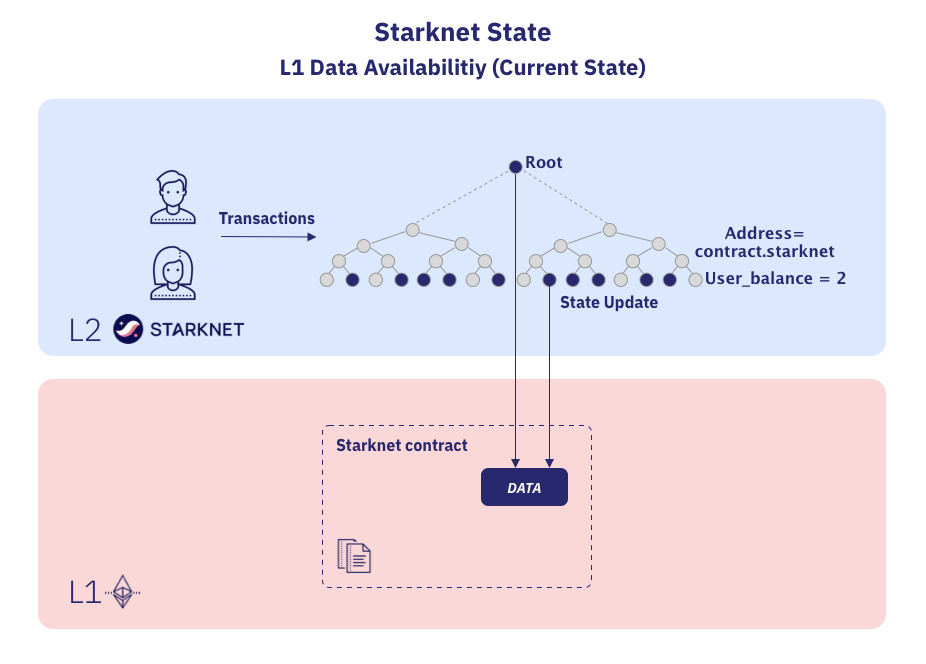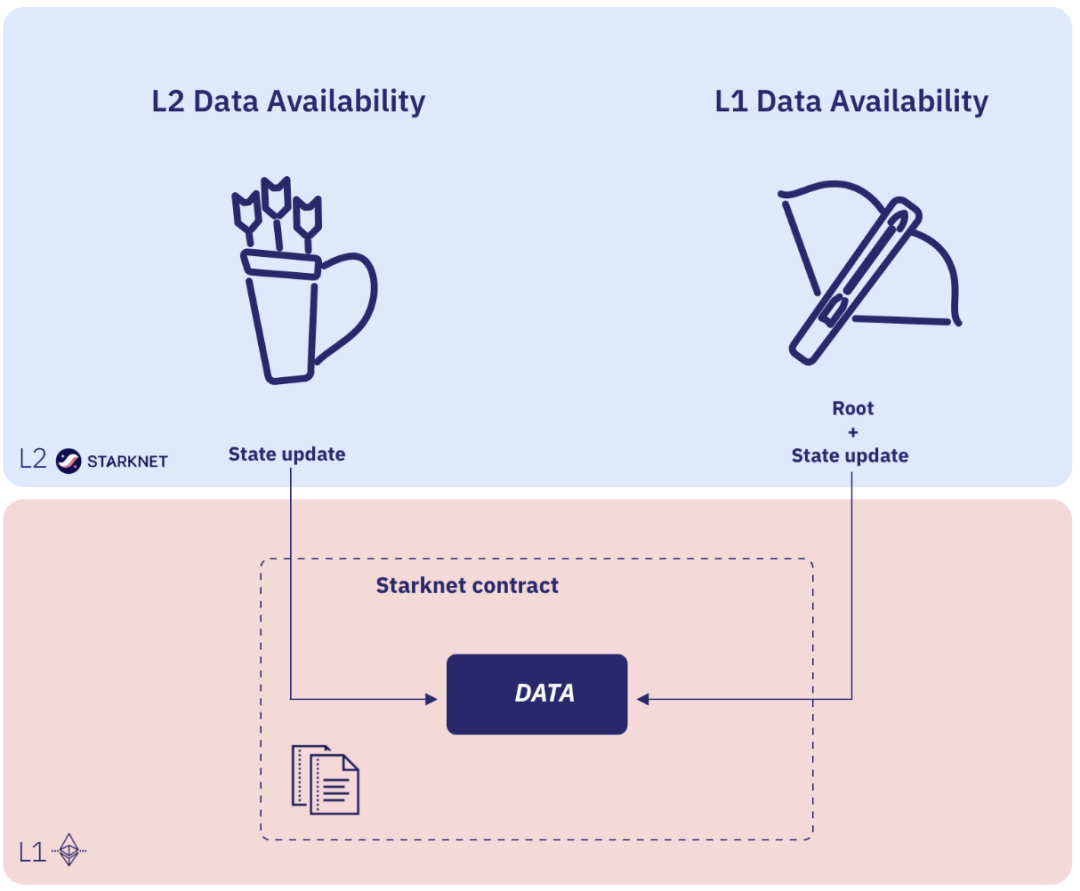Original Text: Volition on Starknet: Your Data, Your Choice
Translation and Proofreading: “Starknet Chinese Community”

Highlights
- Starknet introduces Volition!
- Volition will allow developers to adjust the availability of data on Ethereum (L1) or Starknet (L2). Reducing on-chain data on L1 can fundamentally lower costs.
- The flexibility of data availability patterns will once again provide greater freedom for Starknet developers and users to choose the most suitable security level in an economically efficient manner according to their specific needs.
- Volition is planned to be implemented on the testnet in Q4 2023.
Validity Rollup: Increased Throughput, Reduced Costs
As Ethereum continues to evolve, the need for scalability and cost reduction becomes increasingly urgent. As a scalable and efficient solution running on Ethereum, Validity Rollups have emerged.
- FDIC Report Cryptocurrencies Pose Unique Risks to US Financial Stability
- How does demand drive affect the valuation of cryptocurrencies? Re-examining BTC, ETH, and TRON
- The SEC is expected to give the green light to Ethereum futures ETF it is expected to be listed as early as October, with a total of 16 applications pending approval.
Starknet is an Validity Rollup introduced by the inventor of STARK proof. As an L2, Starknet only submits the necessary data of each transaction to Ethereum (L1) and uses the Shared Prover (SHARP) to distribute the on-chain verification cost of the proof to all transactions within a given batch, achieving large-scale computation while reducing computational costs.
In Q4 2023, Starknet will once again significantly reduce costs and address the major challenge developers face in transaction fees, namely the high cost of on-chain data on L1.
Among the various factors that determine transaction costs, the availability of on-chain data alone accounts for 95% of the average transaction cost. Finding ways to reduce on-chain data on L1 can have a significant impact on overall costs for users and developers. Starknet’s solution to this challenge is: Volition.

Understanding Volition
Currently, Starknet operates in Validity Rollup mode, which means that Starknet’s data and commitments to states are submitted to Ethereum. With Volition, data can be stored on Starknet L2, and developers can choose their data availability pattern at the level of individual storage variables, optimizing their contracts.
As the name suggests, Volition will provide the ability to choose the data availability for applications or transactions. Starknet developers will be able to flexibly adjust throughout the range of data availability, dynamically select their data availability solution, and decide whether the data for their applications is available on Ethereum (L1) or on Starknet (L2), allowing users of the applications to make their own choices.
Volition is achieved by treating Starknet’s state as two different storage commitment trees: one for L1 data availability patterns and another for L2 data availability patterns. The data of the L1 data availability pattern tree will be published on the Ethereum mainnet, while L2 data availability means that transaction data will be updated on L2 and propagated to the Starknet network. Only the commitments (i.e., the “roots” of the commitment trees) of the data will be sent to L1.

It’s Up to You
The security of the data publishing layer determines the level of determinism of data availability. Data published on L1 will benefit from the security level provided by Ethereum and will be as accessible as any other data on Ethereum. On the other hand, data published on L2 will be transmitted to all Starknet L2 nodes, benefiting from the lower cost on L2. This ensures the prevention of risks that minimize failures or malicious behavior, which could hinder withdrawals or deny access to data stored on L2.
Although these necessary measures have been taken to ensure the high security of L2 data availability, we acknowledge that to achieve maximum security, the choice of L1 data availability (DA) should be up to you, as it can provide Ethereum-level security. L2 data availability should only be used when developers and users consider the trade-off between L2 cost and L1 security. We also recommend developers to write contracts that use L2DA so that the contracts can continue to function normally in the event of an L2 data availability crisis (e.g., loss of L2DA assets). In addition, as we launch Volition, we recognize that perfecting innovation takes time. Therefore, Volition will first run on the testnet for a period of time. During this phase, we will actively listen to feedback from the community, optimize it, and gradually align it with the needs of builders.
Introducing Volition on Starknet will improve efficiency and developer experience (DevEx). If developers have the ability to independently find optimal solutions between security and cost, L2 applications will be able to adjust their design based on user needs and reach a wider audience.
Use Cases and Applications of Volition
To best demonstrate the effectiveness of Volition, let’s look at some real-world use cases.
Imagine that you are participating in a highly anticipated Web 3 game on an application built on Starknet. You successfully bid and purchase a high-quality bow and arrow NFT. Considering the importance of this transaction, you may choose the on-chain data availability mode. Thanks to Ethereum’s extensive decentralization, this ensures that the ownership of the bow and arrow is securely recorded on the Ethereum blockchain. Then, you decide to purchase 150 arrow NFTs, and due to their lower value, you can choose L2 data availability to complete the transaction and save costs.

The same concept applies to high-value decentralized transactions, where the primary task of DEX is to ensure the security of funds and minimize transaction fees. Users can keep some funds in their L2 data availability accounts to optimize their trading operations. Using funds stored in L2 data storage allows traders to execute a large number of transactions at lower costs. When the funds in the L2 data availability account reach a higher amount, DEX will prioritize security over cost and transfer the funds to the L1 data availability account. This transfer ensures that most of the funds are securely available on L1.

From these two examples, it can be seen that Volition allows developers and users to choose the data availability mode for each contract, giving them more control, while also enhancing the user’s transaction experience.
When will Volition be launched?
Volition will be launched on the Starknet testnet in the fourth quarter of 2023. It will run on the testnet for a longer period of time in order to understand and strengthen various security issues based on community feedback and experience. Volition is expected to save costs for many users and dApp developers. In the future, Starknet will define other data availability modes, such as Adamantium (a mode that uses a committee to provide data availability and can be chosen by users to provide data availability from trusted parties).
Summary
Starknet’s Volition solves security risks and high on-chain data costs. By allowing data storage on Starknet L2, developers can reduce costs and improve scalability while maintaining the trusted security of Ethereum. There are many benefits to using Volition on Starknet, which may open the door for innovative application development. If you are curious about Volition, feel free to watch the detailed lecture by Avihu Levy, Product Manager at StarkWare, and participate in in-depth discussions on our community forum.
Like what you're reading? Subscribe to our top stories.
We will continue to update Gambling Chain; if you have any questions or suggestions, please contact us!